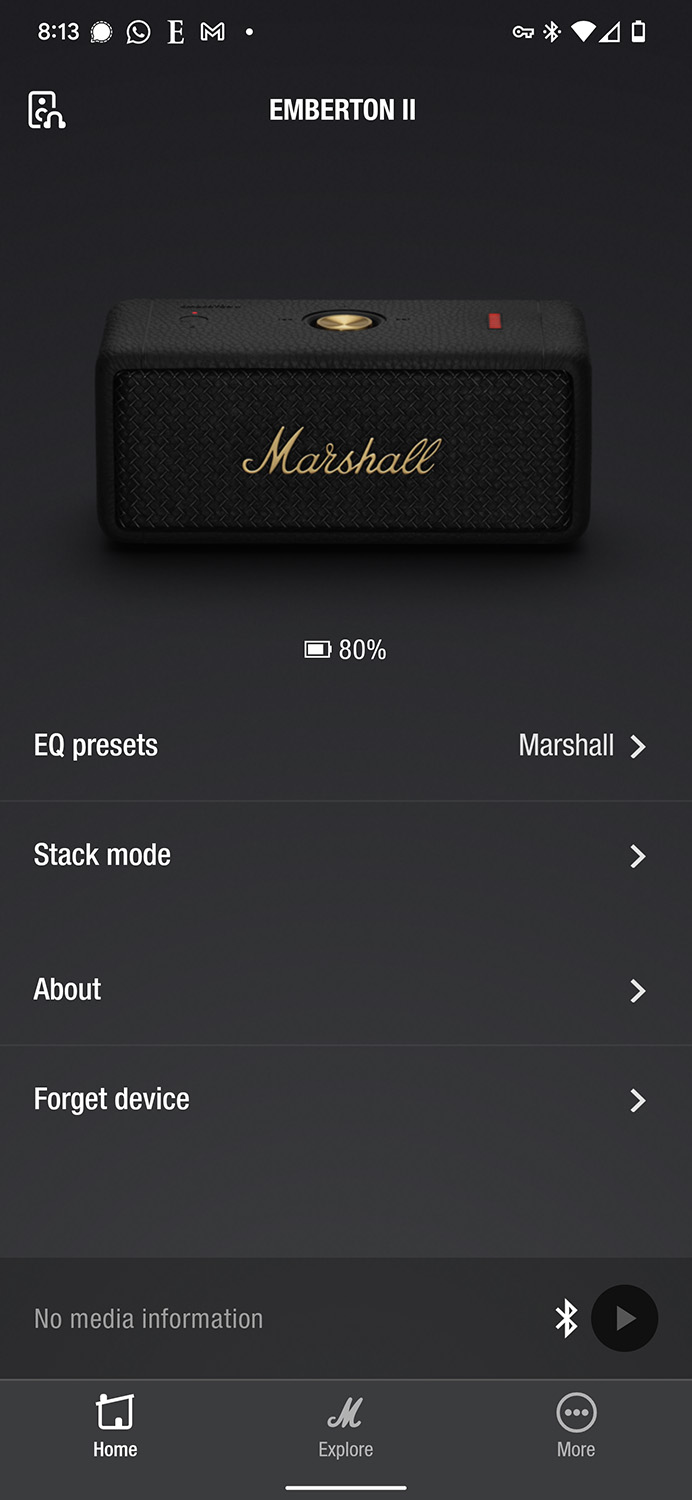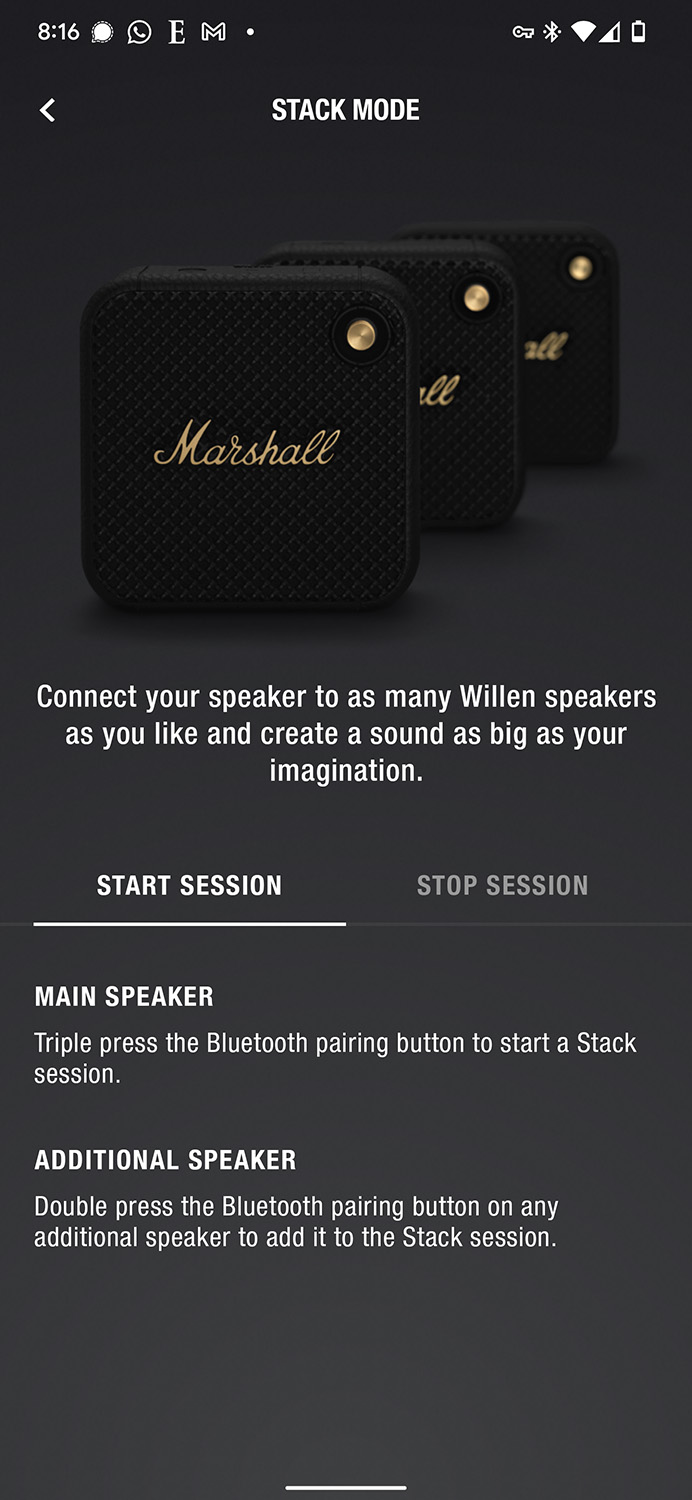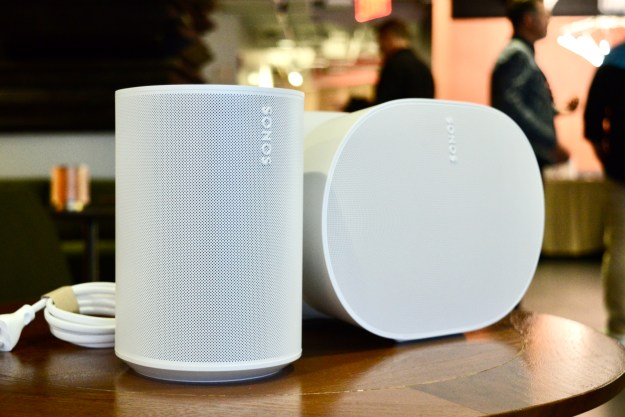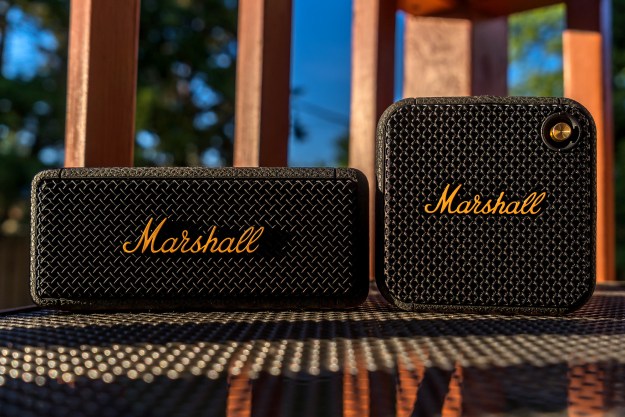
“Press play with Marshall's stylish Emberton II and Willen Bluetooth speakers no matter where you want to go.”
- Excellent sound quality
- Rugged IP67 build
- Easy portability
- Great battery life
- Sync with similar speakers
- No AAC or aptX support
- No wired playback
- Pricey
When it comes to Bluetooth speakers, there’s an insane number of them to choose from. Most are perfectly adequate for casual listening, but if we’re being brutally honest, they’re not much to look at. Marshall’s line of portables neatly avoid the generic speaker trap by leaning into to the brand’s iconic history as one of the most recognizable names in live rock ‘n’ roll. For 2022, it has updated its Emberton speaker — now the $170 Emberton II — and added an even smaller and more portable sibling, the $120 Willen.

Marshall Emberton II
|

Marshall Willen
|
So from a size and style point of view, these two speakers already have a lot going for them. They can even play beyond their respective frames, and we spent a lot of time with them to find out just how far they can go. But has Marshall thrown in enough features and performance to justify its premium pricing on the Emberton II and Willen? Let’s check them out.
What’s in the box
Despite being different speakers, they each unbox exactly the same way, with the same contents inside. Apart from the USB-C charging cable and user manual, there’s nothing else to discover inside. These speakers aren’t exactly made to work with accessories anyway, but I’ll get to that part further down.
Design
Emberton II
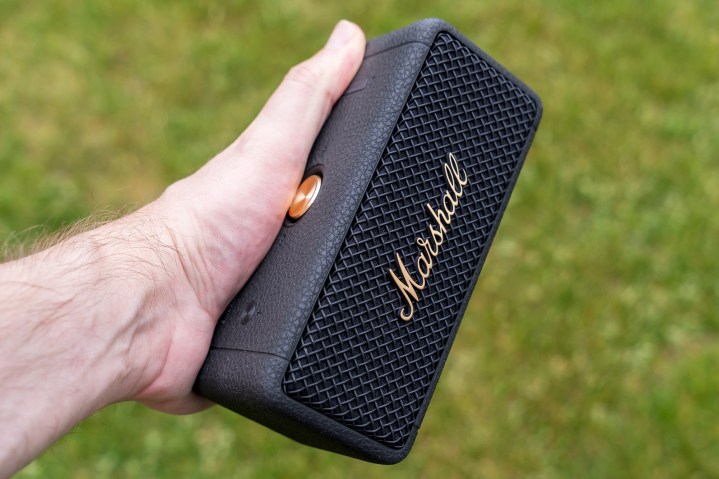
Here, too, the design principles align for both. They’re not new, however, since Marshall largely built the original Emberton the same way. This time, the rubberized veneer has more of a leather texture to it, and the grille is black to accentuate the brass color logo at the front. Marshall did also make a cream variant for this speaker that sports its own retro look in the company’s signature style.
The dimensions of 2.7 x 6.3 x 3.0 inches and weight of 1.5-pounds are identical to the previous Emberton. Marshall also didn’t move the multifunction button, LEDs, or USB-C port. That familiar territory also extends to what’s inside, courtesy of the dual 2-inch drivers with 10-watt Class-D amps and two passive radiators.
So what’s changed? And why is Marshall asking $20 more for the Emberton II? A key change is that you can sync the Emberton II with other Emberton II speakers in what’s called Stack Mode. It works similarly to JBL’s Party Mode and Soundcore’s PartyCast mode.
It’s also more robust, now with dust protection, as well as waterproofing, for a combined IP67 rating. That’s enough to survive full immersion in water for up to 30 minutes at a depth of about three feet, plus any sand or debris that might go along with your beach adventures.
But keep in mind, unlike some other full waterproof portables, the Emberton II does not float. And if you take it into a pool or salt water, you had better give it a thorough rinse in fresh water before putting it away.
Willen
Despite their similarities, it’s not possible to “stack” these two speakers together. The mode only works with the same speaker types. The original Emberton doesn’t support the feature, so there was no way to get it to pair with its successor.

The Willen is the smaller of these two, but arguably the more versatile. It’s a lightweight at 0.68 pounds, and easy to carry with its frame measuring 4 x 4 x 3 inches. It holds one driver and amp, instead of two, though it does also have two passive radiators. A rubber strap on the back also lets you mount it onto whatever it can wrap around.
It’s cool to have, but I did run into some issues with it, like when it was too short to strap onto my bike’s handlebars. It’s also not as stretchy as it looks, so the application is going to be hit-or-miss. You may find success with a thinner bar, or on a bag, as there is no real defined application for it. Whatever you can strap it onto is really up to you.

Marshall claims 60% of the Willen’s plastic comes from recycled electronics, a little further ahead of the 50% it uses to make the Emberton II. Whatever Marshall put in these two, it did make them fairly rugged and tough. The Willen shares the Emberton II’s IP67 rating.
Setup and Marshall app
There’s not much to setting these two up, and the process is identical for both. On Android devices, Google Fast Pair will pop up once you establish contact, though it’s best to already have the Marshall app installed on your phone to speed up the process. On iOS, it’s not all that different, with the app helping to pair up with your iPhone or iPad in no time.
The Marshall app is the other big change for the Emberton II. The original model had no companion app at all, so things like settings changes or firmware updates weren’t available. It’s not an especially feature-rich addition. It lets you monitor each speaker’s battery level, access three EQ presets (Marshall’s own signature tuning, Push for bass boost, or Voice for enhanced spoken word content), and engage Stack Mode.
With only one of each speaker on hand, I wasn’t able to test Stack mode, so I’m not entirely sure how well it works or sounds. What is clear is that the app makes the connections, and it treats the first speaker as the “main” while any others act as the additions. There’s no official limit to how many you can stack this way. Marshall claims it has linked as many as 30 speakers with no problems. Unfortunately, there’s no way to use Stack Mode to create a stereo pair between two similar Marshall speakers, but you can connect a single speaker to two Bluetooth sources simultaneously, which lets you seamlessly share DJ responsibilities with a friend.
Controlling the speakers is easy. Both use a brass multifunction button that doubles as a directional pad. Press and hold to power on or off, or hold it longer to put it back in pairing mode. Pressing left or right will repeat or skip a track, while up and down raises or lowers volume. The controls and battery life indicator do the exact same things on both the Emberton II and Willen.
The Willen is the only one of the two with a built-in microphone for calls. You can’t talk to anyone with the Emberton II, so you’re out of luck if you were hoping for some speakerphone functionality. It’s not remarkable, but the Willen does a good job with calls, and aside from a couple of connectivity hiccups, conversations went smoothly.
Sound quality

Neither the Emberton II nor the Willen support the AAC or aptX codecs. They’re going all the way with SBC, so if you’re thinking of going hi-res with your tunes, these two aren’t an option. Without a 3.5mm Aux-In jack, there’s no way to go wired, and the USB-C port, is only for charging. I tried playing music through it on both speakers, but nothing happened.
The good news is they get louder than you would expect. There’s real power inside, with pleasant clarity, particularly in the 40% to 60% volume range. I barbecue a lot, and I had one or the other of these speakers near me during the time I was testing them. I really enjoyed the Emberton’s resonance while hearing the barbecue’s sizzle as I was grilling, and I kept it going by listening to a podcast as I had my meal. I topped it all off with a drink and cigar. Either speaker just fit in with the situation and environment, and the portability only made that easier.
One thing to keep in mind with both speakers, however, is the way Marshall splits the stereo output. The front grille takes the left channel, while the back grille outputs the right. Marshall calls this “true stereophonic” sound, and it does indeed provide a sphere of audio that sounds great from any direction. But there are two caveats: You don’t quite get the left/right stereo separation you may be used to from traditional one-sided speakers and placing these speakers in locations where the front and back have unequal room to breathe will affect sound quality, so try not to stash them in a bookshelf or too close to a wall.
I tried the Push EQ preset to gauge how much bass came out, and while very impressive, I did notice a catch. Push is supposed to boost the bass, which it does, but it loses some of its rumble when you blast it. Both the Marshall and Push presets were designed to offset the speaker’s limitations, meaning that raising the volume to the highest levels didn’t lead to obvious distortion, but it lessened the bass to keep the audio as clear as possible. That actually works out well for rock and guitar tracks, where bass isn’t as prevalent, but if you’re blasting hip-hop and R&B, you might find the effect a little surprising.

It’s understandably more pronounced on the Emberton II than it is on the Willen, considering the size and output differences, but the gist is the same. Go really high, and the same thing happens. Even so, the Willen was a pleasure to have around in the same circumstances. Sure, it didn’t have the same beefy sound its larger brother does, but when you’re just lounging in a chair or sitting with a friend at a table, it’s a super-convenient thing to have.
The Emberton II is certainly heavier and bulkier, though not that much less portable if you’re throwing it into a bag. It gets up and running quickly, and can very easily play tunes loud enough for a small group of people. It will sound louder indoors than outdoors, but there’s no question it works for smaller gatherings outside.
Battery life
Want one more reason to spend the extra $20 for the Emberton II over its predecessor? Battery life is now 50% longer. Marshall claims at least 30 hours of playback per charge (a 10-hour increase over the Emberton), which is mostly accurate if you don’t raise the volume above 50%. Keep it at full blast (or close to it) and you’re cutting it down by more than half. That’s still pretty good, all things considered, so if you’re listening at a regular volume, you won’t be charging it all that often. A quick 20-minute charge will get you up to four hours of playback, and a full charge from a dead battery will take three hours.

The Willen follows a similar pattern. At a largely default volume, it will hit its rated 15-hour limit, and maybe more. Crank it up, and you’ll be charging it again by the end of the night. A quick 20-minute charge can give you up to another three hours playback, and it takes three hours to fill it up completely.
Our take

Marshall Emberton II
|

Marshall Willen
|
Given how they look and sound, it was easy to like both the $170 Emberton II and $120 Willen. The retro styling and ruggedized build were made for all seasons, regardless of whether you’re chilling at the beach, or hitting the slopes in winter. You don’t get bells and whistles, just music that can get loud and proud when you want it. If Marshall’s sound rings true to your ears, these would be well worth a look.
Is there a better alternative?
Both of these speakers play their tunes in competitive spaces. The Ultimate Ears Megaboom 3 stands out against the Emberton II with its cylindrical build and more intricate EQ, though it won’t last as long per charge and may cost more. For less money, the JBL Flip 6 also goes the cylindrical route and offers similar pairing features with other speakers of its type. Loud, rugged, and with a deeper EQ, it’s got more of a sporty vibe to it, too.
Ultimate Ears can also take on the Willen with its cheaper Wonderboom 2, which also has a cylindrical build that floats on water, though it won’t get as loud as Marshall’s speaker does. The Tribit Stormbox Micro 2 is a budget option with a durable frame that also comes with its own strap to mount where you need it.
How long will they last?
Their respective durability suggests the Emberton II and Willen are built to last. You do have to take care of them by rinsing off any salt, sand, or dirt that may stick to them. They are made tough, just not impervious to all bumps and encounters with the elements. Marshall offers a one-year warranty to cover malfunction issues, but not water damage.
Should you buy them?
Yes, because they sound better than most speakers at the same size, and despite lacking some features, they’re undeniably stylish in that classic Marshall way. You can pre-order both from MarshallHeadphones.com right now, and they’ll ship on June 30, 2022.
Editors' Recommendations
- Best wireless speakers for 2024: Sonos, JBL, KEF, and more
- Klipsch takes on Marshall with three new portable and rugged Bluetooth speakers
- Bluetooth bandwidth set to double, opening a path for video and lossless audio
- The best Bluetooth speakers for under $100
- The best waterproof Bluetooth speakers for 2023: from JBL, Marshall, and more


